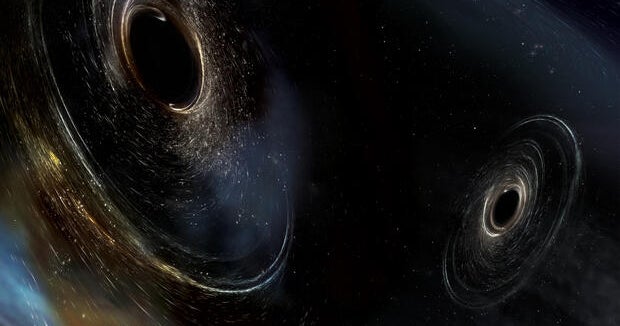In a groundbreaking discovery, scientists have reported the largest merger of two black holes, creating a single entity with a mass 225 times that of the Sun. This finding, announced by the LIGO-Virgo-KAGRA Collaboration, challenges existing theories about black hole formation. The merger displays characteristics that push the boundaries of current astronomical understanding, as researchers delve into the implications of this phenomenon.
| Article Subheadings |
|---|
| 1) The Record-Breaking Merger |
| 2) Details of the Black Holes |
| 3) Implications for Astrophysics |
| 4) Future Research Directions |
| 5) Upcoming Conferences |
The Record-Breaking Merger
The merger event, referred to as GW231123, has been identified by the LIGO-Virgo-KAGRA Collaboration, an international consortium dedicated to detecting gravitational waves. This remarkable event occurred in November 2023 during a dedicated observation period spanning several months. The observation window is significant, extending from May 2023 to January 2024, indicating a systematic effort to monitor and analyze cosmic phenomena.
Gravitational waves, ripples in spacetime produced by massive cosmic events, provide a window into the universe’s most extreme conditions. As LIGO and its partners refine their detection methods, the identification of GW231123 represents a new pinnacle in their endeavors, offering insights into the universe’s darker counterparts.
Details of the Black Holes
The two black holes involved in this merger were substantial in their own right: one possesses a mass approximately 103 times that of the Sun, while the other boasts an impressive mass of around 137 solar masses. According to Mark Hannam, a professor at Cardiff University and a member of the LIGO Scientific Collaboration, these immense black holes likely originated from previous mergers. This suggests a cascading effect, where prior black hole collisions contribute to the formation of even larger entities.
Adding to the intrigue, the black holes were found to be spinning at incredible speeds—roughly 400,000 times that of Earth’s rotation. Their velocities reach approximately 80% to 90% of the theoretical maximum, providing further evidence of the extreme and dynamic nature of black hole physics.
Implications for Astrophysics
The unprecedented size and characteristics of GW231123 pose significant questions for astrophysicists. The discovery “pushes the limits” of existing theoretical models concerning black hole formation, according to experts.
“The black holes appear to be spinning very rapidly—near the limit allowed by Einstein’s theory of general relativity,”
said Dr. Charlie Hoy, a gravitational-wave astrophysicist and LIGO member. The complexity of the signal emitted during the merger poses challenges for accurate modeling and interpretation.
This new finding is poised to inspire a reevaluation of the mechanisms that lead to black hole mergers and the environmental conditions required for their creation. Dr. Gregorio Carullo, another member of the LIGO team, expressed optimism about future research directions, noting that it may take years to dissect the intricate signal patterns produced by GW231123 and fully understand its implications on a cosmic scale.
Future Research Directions
The implications of the GW231123 discovery are numerous, and astronomers anticipate that it will open new avenues for research in gravitational-wave astronomy. The complexity of the merger’s signal may indicate more than just a simple black hole merger, potentially suggesting new physical scenarios that need to be explored. As the scientific community seeks to unravel these surprises, researchers are encouraged to consider unconventional explanations that may offer clarity on this extraordinary event.
This groundbreaking discovery is particularly timely as the LIGO-Virgo-KAGRA Collaboration prepares to release further data from their recent observation period. The ensuing studies and experiments will aim to shed light on the underlying physics that led to the formation of GW231123, as well as enhance the understanding of black holes more broadly.
Upcoming Conferences
In keeping with the collaborative spirit of this research, significant discussions about GW231123 and other discoveries will be presented at the upcoming 24th International Conference on General Relativity and Gravitation (GR24) and the 16th Edoardo Amaldi Conference on Gravitational Waves. These conferences will be held jointly in Glasgow, Scotland, providing a platform for some of the brightest minds in astrophysics to converge and share their findings.
Data collected during this period will be made available to fellow researchers, creating an opportunity for further exploration and understanding of gravitational waves. This collaborative approach among scientists in the global research community will play a critical role in developing future frameworks for black hole studies and gravitational wave observations.
| No. | Key Points |
|---|---|
| 1 | Discovery of GW231123 marks the largest black hole merger known to date. |
| 2 | Black holes involved were 103 and 137 times the mass of the Sun, respectively. |
| 3 | The merger presents new challenges for existing astrophysical theories. |
| 4 | Future conferences will facilitate the discussion of new data and findings. |
| 5 | In-depth analysis of GW231123’s implications may take years to fully uncover. |
Summary
The discovery of the largest black hole merger to date, GW231123, not only extends the boundaries of current astrophysics but offers a promising landscape for future research. As scientists continue to dissect the implications of this merger, our understanding of black holes and the dynamics of the universe may shift dramatically. This finding emphasizes the need for collaborative research efforts and advanced technologies to explore the cosmos further.
Frequently Asked Questions
Question: What is GW231123?
GW231123 is the designation for the largest black hole formed from the merger of two smaller black holes, detected by the LIGO-Virgo-KAGRA Collaboration.
Question: Why is this discovery significant?
This discovery challenges existing theories regarding how black holes form and grow, pushing the boundaries of current astrophysical understanding.
Question: What role do gravitational waves play in this discovery?
Gravitational waves serve as the primary means of detecting mergers of black holes, providing critical data for scientists to study these cosmic events.


